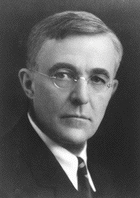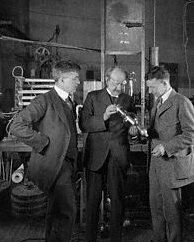April 18, 1916: Langmuir Patents the Incandescent Lamp
 Irving Langmuir  |
He was also influenced by his older brother, Arthur, a chemist, who helped Langmuir set up his first lab in the corner of his bedroom.
In 1892, the family moved to Paris. Upon returning to America, Langmuir graduated from the Pratt Institute's Manual Training High School in Brooklyn and went on to earn a BS in metallurgical engineering from the Colarado School of Mines in 1903.
Langmuir attended graduate school at Gottingen University, working under Walter Nernst, who was both a theoretician and an inventor of the so-called "Nernst glower", an electric lamp.
Langmuir's PhD in 1906 was granted for research done using Nernst's lamp, attempting to determine what happened to various gases produced in the presence of a hot platinum wire. This work laid the groundwork for many of his later interests.
He returned to the US to teach chemistry at Stevens Institute of Technology in Hoboken, New Jersey.
After spending the summer of 1909 doing research with the General Electric Company in Schenectady, New York, he accepted a position there as a researcher. The focus of his early research was on the use of the lightbulb for the study of gas at varying temperatures and pressures, similar to his thesis research in Gottingen.
His first project was to solve the problems the company was having with the new tungsten filament light bulbs: the lamps would "blacken" or grow dim as the inside of the bulb became coated with evaporated tungsten. Based on his investigations of the chemical reactions catalyzed by the hot tungsten filament, Langmuir found that the presence of nitrogen slowed the evaporation process, and that thin filaments radiated heat faster than thick filaments, while coiled tungsten wire radiated heat as if it were a solid rod. He suggested filling the bulbs with nitrogen (and later, argon) gas, and twisting the filament into a spiral form to inhibit the vaporization of tungsten.
His improved device, patented on April 18, 1916, soon made the Nernst lamp and others like it virtually obsolete, and is the basis for the design still used today.
However, the work for which Langmuir is best know is his work in surface chemistry, as well as his elaboration on the theory of chemical bonding in terms of electrons, first expressed by Gilbert Lewis.
In Lewis's model electrons formed stable groups of eight at the corners of a cube. Langmuir proposed that these octets could be filled by sharing pairs between two atoms: the "covalent" bond.
In the area of surface chemistry, he developed a new concept adsorption, in which every molecule striking a surface remains in contact with it before evaporating, thus forming a firmly held monolayer.
He was awarded the Nobel Prize in chemistry in 1932 for this work, the first nonacademic chemist to be so honored.
Throughout his long, productive life, Langmuir made many other significant contributions in both physics and chemistry.
He discovered hydrogen in its atomic form, which led to the development of an atomic hydrogen welding torch that produced a flame of such high temperature that it is still used for welding metals which are not affected by the standard oxyacetylene. His studies also offered the first clear picture of thermionic emission: the flow of charged particles from hot metals.
He was among the first to work with plasmas, and actually coined the term to describe the aggregations of ionized gas with unusual electric and magnetic properties.
And he introduced the concept of electron temperature and invented the device to measure it: the thermionic probe.
Furthermore, his research helped develop technology employed to win both World Wars: submarine detection devices during WWI, which Langmuir later drew upon to improve the quality of sound recordings; and the development of protective smoke screens and methods for de-icing aircraft wings. The latter research led to his work in the somewhat controversial area of weather control, using dry ice pellets and silver iodide crystals to seed clouds.
Langmuir's other interests encompassed far more than just science. Mount Langmuir in Alaska is named after him; he was a lifelong avid climber who climbed the Matterhorn and explored the Adirondacks. He also flew airplanes, skied, skated, and once walked 52 miles in one day. He was the subject of a 1999 documentary for public television, "Langmuir's World," directed by his grandson, Roger Summerhayes.
And his association with GE colleague Bernard Vonnegut—brother to novelist Kurt—led to his being a model for a character in Vonnegut's novel, Cat's Cradle.
Langmuir also contributed the notion that there might be a form of ice that remains crystalline at room temperature, which Vonnegut dubbed "ice-nine." Langmuir died in Woods Hole, Massachusetts in 1957.
©1995 - 2024, AMERICAN PHYSICAL SOCIETY
APS encourages the redistribution of the materials included in this newspaper provided that attribution to the source is noted and the materials are not truncated or changed.
Associate Editor: Jennifer Ouellette
April 2003 (Volume 12, Number 4)
Articles in this Issue

